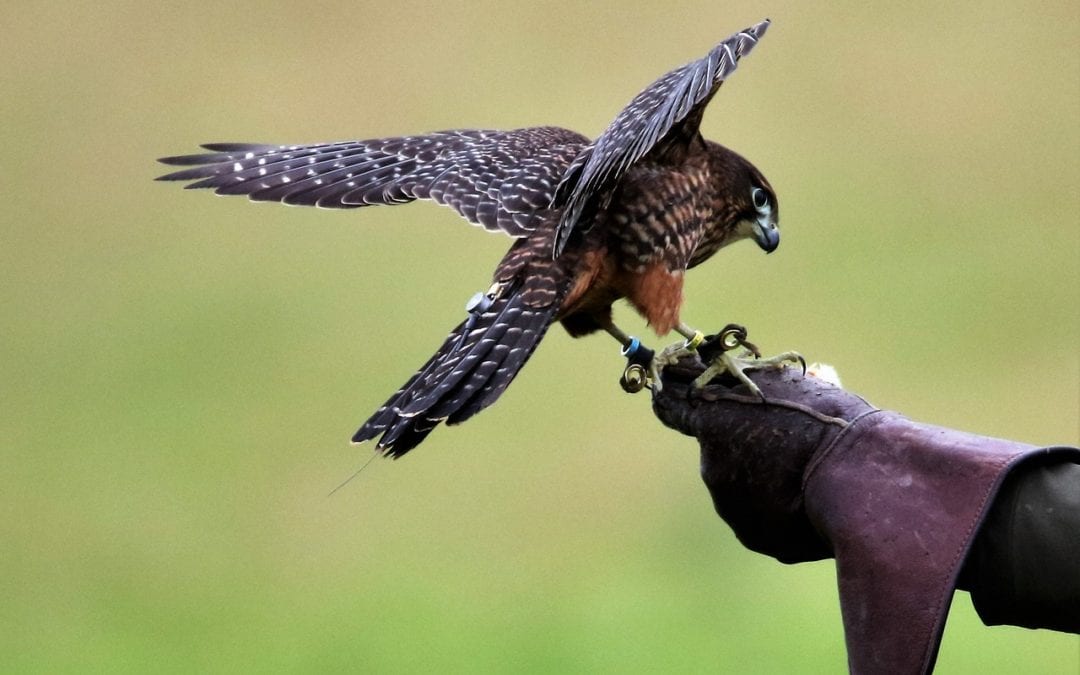I only know of two licensed falconers on our end of the state. One hunts in Ohio and I haven’t seen him in years. The other got his license this year and caught a red tailed hawk on the first day of the season Sept 1st. I had too many commitments to take a hawk that early in the season, so I waited a few weeks to start. Mike’s luck did not pass on to me. Even though he went with me several times and his sponsor was helping us look, we were unable to catch anything until a few weeks ago. That is when we caught Half Pint, Tiny Hawk, Focus and training began. We had caught a young kestrel, the smallest North American falcon.
My little falcon needed to trust me and then need me. So we sat side by side in my office. Of course, I did accounting (and falconry gear shopping) while she rearranged much of my office with her flying. The first step for falconry training is training the bird to stand on the fist comfortably. With a wild caught red tailed hawk, this can be a few days. With a nervous sharp shinned, it might be a week or more. I was back at Guardian Animal about noon on the Sunday we caught her. Half Pint was fitted with temporary jesses and was standing on the leather falconry glove within an hour.
To bate is to fly off the glove or the perch for no good reason. Birds do it when they are startled, frightened or mad. Returning to the fist or glove after a bate is an important second step of training.
Eating off the fist is something that happens after the other two. It will happen when the bird is calm and trusting the falconer enough. Kestrels are naturally fairly trustworthy and don’t need as much weight reduction to eat, so by 4:07pm the first afternoon, I had a short video of Half Pint eating tiny tidbits of previously frozen mice off my finger while sitting on the glove. I know because I was so ecstatic that I texted the video to Mike. Mind you, she would gently eat off my finger, but nab and twist my skin with her beak if she was mad about something and she was often mad about everything!
Sitting on the perch and returning to the perch after a bate are the next two steps. She was definitely doing this by the end of the second day. She is good at it now at the beginning of a training session, but as we progress, she loves to perch on my tissue box, my stereo and the back of my chair. By Wednesday, she was hopping to the fist. This took me weeks with Jim, the red tailed hawk that had an injury. I was certain that Tiny Hawk was on the fast track and we would be hunting starlings within two weeks. I still wasn’t sure of her permanent name.
Thursday and Friday were training setbacks. They were the days that caused me to believe that I didn’t have enough time for falconry. There were urgencies, emergencies, personnel and client issues. I left GAMC after 10:30pm both nights. I was exhausted. I personally have to feed both of my raptors, but I didn’t achieve any training. They were checked, weighed and fed. I skipped supper, I was so mentally exhausted. By Saturday, she weighted 10 grams more than when she was captured. In short, she had no reason to do anything with me. Saturday and Sunday we spent time together. She sat on her perch on my desk and I attended a dental seminar, prepared the monthly taxes, reconciled bank accounts and paid bills. She even felt comfortable enough to take a nap.
On her 8th day of captivity, I took her away from the distractions of my office. We found an empty ward and practiced. She returned to hopping up onto the glove, but it wasn’t until Friday that she would fly a couple of feet to my glove. I think the two days cost me a week of training time.
Next up is lure training. My lures are all hawk sized, so Mike volunteered to fashion a bat sized lure for her. She is now officially Focus. When the lure training is good, she will fly outside on a creance or long, light leash. Then free flying outside and then catching game. Of course, that might include grasshoppers and cicadas, because my small falcon usually eats insects in the wild. For now I have a desk falcon, a Half-Pint-Tiny-Hawk named Focus.

